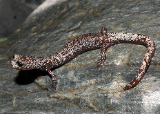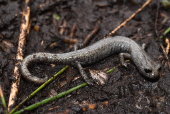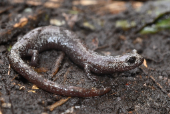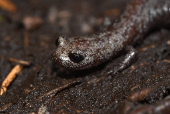Inyo Mountains Salamander (Batrachoseps campi)
Description: Batrachoseps campi is one of the largest slender salamanders, a genus otherwise mainly made up of very small species, and can grow to over 6 cm in length. It has a relatively broad head, and is colored brown with numerous gray speckles. These speckles often cover most of the salamander, making it appear silvery-gray. Like all Batrachoseps salamanders, it has only four toes on its hind feet. It has no dorsal stripe, a trait shared within Batrachoseps only with Batrachoseps gabrieli.
Habitat: The Inyo Mountains are extremely dry, especially at low elevations, resulting in Batrachoseps campi being largely restricted to small permanent springs inside steep canyons on both sides of the range. However, pitfall traps have recorded individuals far from these water sources, indicating that the species' underground distribution may occupy significantly more of the mountain range.
Range: Batrachoseps campi is endemic to the Inyo Mountains and limited to 20 known localities, located in Inyo County in eastern California, occupying a wide range of elevations from 1,800 to 8,040 feet. Despite the nearby White Mountains (which are connected to the Inyo Mountains to the south) having similar canyon springs with riparian-restricted endemic species that overlap with the range of this species (such as the Panamint alligator lizard), Batrachoseps campi has never been recorded in the White Mountains or at any springs north of Waucoba canyon. The northernmost and southernmost localities where B. campi has been recorded are separated by only about 40 km.
Found in these States:
CA |
NV
Diet: Batrachoseps campi eats small insects and invertebrates.
Reproduction: No eggs have ever been found, but it is assumed that this species reproduces like all other Batrachoseps slender salamanders without an aquatic larval stage.
Status: Listed as Near Threatened because the status of this species is dependent on the protection and rigorous management of its habitat by various federal agencies. Without this protection, the speciesí habitat could be degraded and fragmented resulting in significant population declines, that would likely warrant its uplisting to a more threatened category. Ongoing effects of climate change in many canyon strongholds for this species, particularly more frequent or intense flash floods and drought, are considered the most significant concern and deserve continued monitoring as a population-level threat.
»» Kingdom: Animalia - Animals
»» Phylum: Chordata - Chordates
»» Subphylum: Vertebrata - Vertebrates
»» Class: Amphibia - (Amphibians)
»» Order: Caudata - Salamanders
»» Family: Plethodontidae - Lungless Salamanders
»» Genus: Batrachoseps
»» Species: Batrachoseps campi - Inyo Mountains Salamander
This article uses material from the Wikipedia article "Inyo Mountains Salamander", which is released under the Creative Commons Attribution-Share-Alike License 3.0. Content may have been omitted from the original, but no content has been changed or extended.
|












